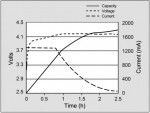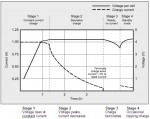Battery University is a source of information I’ve learned to trust. Here’s more than you probably want to know about Lithium Iron batteries. Voltages are per cell.
Battery University / Cadex Corporation
And finally:
When the battery is first put on charge, the voltage shoots up quickly. This behavior can be compared to lifting a heavy weight with an elastic band. The lifting arm moves up quickly but the weight lags behind. The voltage of the charging battery will only catch up when the battery is almost fully charged (see Figure 3. This charge characteristic is typical of all batteries.
Li-ion cannot absorb overcharge, and when fully charged the charge current must be cut off. A continuous trickle charge would cause plating of metallic lithium, and this could compromise safety. To minimize stress, keep the lithium-ion battery at the 4.20V/cell peak voltage as short a time as possible.
Once the charge is terminated, the battery voltage begins to drop, and this eases the voltage stress. Over time, the open-circuit voltage will settle to between 3.60 and 3.90V/cell. Note that a Li-ion battery that received a fully saturated charge will keep the higher voltage longer than one that was fast-charged and terminated at the voltage threshold without a saturation charge.

Relying on the closed circuit voltage (CCV) to read the available capacity during charge is impractical. The open circuit voltage (OCT) can, however, be used to predict state-of-charge after the battery has rested for a few hours. The rest period calms the agitated battery to regain equilibrium. Similar to all batteries, temperature affects the OCV. Read “How to Measure State-of-Charge”
And here’s more reading on How to Measure State of Charge. I’ve been using this information successfully for three years now. All of our electricity comes from a combination of a 4KW Onan and a deep discharge battery pack. I use the resting voltage, measured first thing in the morning and the final charging voltage and current to keep track of the battery state of charge. Three years in and I haven’t killed the house batteries.


